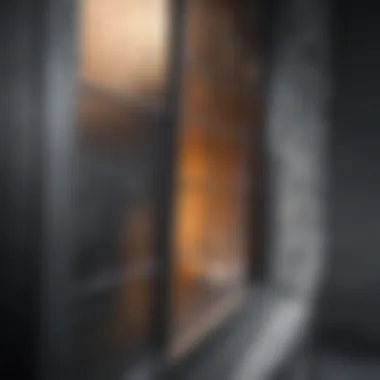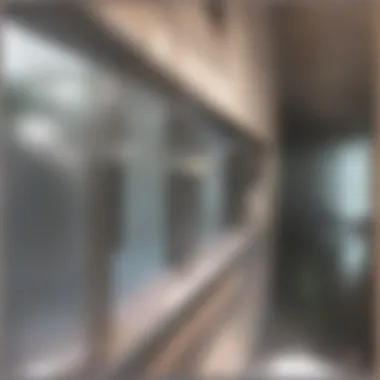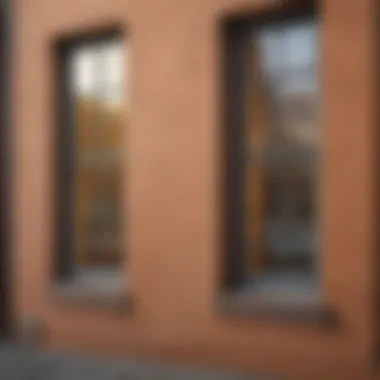Exploring Hybrid Windows: Benefits and Insights


Intro
Hybrid windows emerge as a cutting-edge solution at the crossroads of traditional window designs and modern materials technology. These windows synthesize various materials, taking advantage of their individual properties to enhance performance, aesthetics, and energy efficiency. Given the escalating interest in sustainable building practices and environmentally friendly solutions, understanding hybrid windows becomes increasingly significant. This article aims to dissect their characteristics, advantages, and relevance in contemporary architecture, equipping readers with knowledge about this innovative design.
Background and Context
Overview of the research topic
The concept of hybrid windows originated from a necessity for better-performing window solutions. Traditional windows, often constructed using a single material, face limitations concerning thermal efficiency, durability, and aesthetic versatility. In contrast, hybrid windows combine materials such as wood, vinyl, and aluminum, creating a multifaceted approach that can tackle these issues. The intersection of these materials leads to improved energy retention, making them an appealing choice for modern homes.
Historical significance
Historically, window design has evolved significantly. In the past, wooden frames dominated due to aesthetic appeal and insulation capabilities. However, as the focus on energy efficiency and sustainability increased, new materials and combinations were explored. The introduction of vinyl and aluminum has allowed for low-maintenance options but presents their own set of challenges regarding insulation. Therefore, hybrid windows present a historical culmination of design evolution and material exploration, representing an advance in how we approach the construction and renovation of buildings.
Key Findings and Discussion
Major results of the study
Research into hybrid windows indicates several key benefits:
- Enhanced energy efficiency: Hybrid windows typically outperform traditional windows in energy retention. This is due to the superior insulating properties that multiple materials provide.
- Aesthetic flexibility: These windows offer a diverse range of styles to fit different architectural needs, allowing homeowners to customize their spaces without compromising functionality.
- Durability and low maintenance: Many hybrid windows are designed to require less upkeep than traditional wood windows due to their synthetic components, reducing long-term costs.
Detailed analysis of findings
The integration of materials leads to specific improvements that are worth highlighting:
- Thermal performance: Properly designed hybrid windows can considerably lower heating and cooling costs, a crucial factor in their selection by homeowners and builders alike.
- Environmental impact: Many hybrid solutions use recycled materials or are designed to be more sustainable, aligning with the growing trend toward green construction.
- Market analysis: Recent studies suggest a rising demand for hybrid windows as more consumers become aware of their benefits. This trend is likely to continue as energy costs fluctuate and as sustainability focuses grow in importance.
"The synthesis of different materials in hybrid windows not only boosts performance but also opens new design avenues previously limited by traditional materials."
Culmination
In summary, hybrid windows signal a pivotal shift in window technology, offering enhanced performance and aesthetic options that cater to modern demands. Understanding these innovations propels homeowners and builders towards informed decisions that uphold both functionality and design principles in architecture. The discussions within this article outline the primary considerations influencing the adoption of hybrid windows, providing a comprehensive guide to their potential in contemporary construction.
Understanding Hybrid Windows
Hybrid windows represent a unique blend of materials and technology, setting them apart from traditional window designs. The concept of hybrid windows encompasses both aesthetic and functional elements. As construction techniques evolve, the demand for efficient, durable, and versatile building materials has surged. This section aims to clarify what hybrid windows entail, their historical background, and why they are significant in today’s architectural landscape.
Definition and Overview
Hybrid windows combine different materials to achieve optimal performance. Typically, they merge the insulating properties of wood with the durability of aluminum or vinyl. This fusion allows creators to design windows that meet specific needs such as high energy efficiency and moisture resistance.
Key features of hybrid windows include:
- Energy Efficiency: These windows often come with advanced insulation features, leading to lower heating and cooling costs.
- Aesthetic Options: The use of various materials permits a wide range of styles, appealing to diverse architectural preferences.
- Maintenance: Hybrid designs usually require less maintenance compared to traditional wooden windows.
In summary, hybrid windows provide an innovative solution, allowing homeowners to choose functionality without compromising on style.
Historical Development
The development of hybrid windows has roots in evolving architectural needs and advancements in material science. Historically, windows were made primarily from timber. While wood offers warmth and charm, it has its limitations regarding durability and insulation performance. As building practices and technologies progressed in the late 20th century, manufacturers began exploring alternative materials.
The introduction of materials like PVC and fiberglass allowed builders to enhance window properties. Combining these materials with traditional wood led to the birth of hybrid windows, which started appearing in the market in the 1990s. This shift addressed the need for energy-efficient designs that also provided aesthetic appeal. Today, as concerns regarding climate change and energy consumption grow, hybrid windows are seeing an upward trend in usage, proving their relevance in sustainable architecture.
"The evolution of building materials has enabled hybrid designs to emerge as a leading choice for modern construction projects.”


Material Composition
Understanding the material composition of hybrid windows is critical in evaluating their performance and advantages over conventional designs. The choice of materials directly influences factors such as energy efficiency, durability, and aesthetic appeal. Hybrid windows combine elements from different materials, optimizing the strengths of each while minimizing weaknesses. This innovative approach allows hybrid windows to achieve superior performance in numerous aspects, making them increasingly attractive for modern construction projects.
Common Materials Used
Hybrid windows typically utilize a combination of materials including wood, vinyl, fiberglass, and aluminum. Here are some common materials:
- Wood: Valued for its natural aesthetic and thermal insulation properties. However, it may require more maintenance than other materials.
- Vinyl: Known for its durability and low maintenance. Vinyl also offers excellent weather resistance.
- Fiberglass: Offers high strength and thermal efficiency, making it a popular choice for performance-oriented designs.
- Aluminum: Provides structural support and versatility in design. However, it may not insulate as well as other materials.
The combination of these materials in hybrid design results in a window that balances thermal performance with aesthetic flexibility. Moreover, this unique blend can cater to specific environmental and architectural needs, pushing the boundaries of traditional window construction.
Material Properties
Each material contributes distinct properties to hybrid windows that enhance their functional capabilities:
- Thermal Resistance: Materials such as fiberglass and wood offer superior insulation, reducing the energy cost of heating and cooling homes.
- Strength and Durability: Aluminum frames provide structural integrity and longevity, while vinyl resists rot and corrosion.
- Maintenance Requirements: Vinyl and aluminum require less upkeep compared to wood, which can suffer from wear over time if not properly maintained.
- Aesthetic Options: The hybrid approach allows for diverse finishes and designs, enabling homeowners to customize their windows to match architectural styles and personal preferences.
"Hybrid windows serve as a modern solution, merging traditional materials with the latest technology to address the needs of contemporary architecture."
In summary, the material composition of hybrid windows plays an essential role in their overall performance and appeal. The combination of different materials not only enhances their functional characteristics but also meets the evolving demands of sustainable and efficient architecture.
Functionality and Performance
In the realm of window design, the functionality and performance of hybrid windows are essential considerations. This section explores how these windows exceed traditional constructions in various ways, offering enhanced levels of energy efficiency, thermal insulation, and acoustic performance. Understanding these aspects is vital for homeowners, builders, and industry professionals as they make informed choices about which products best serve their needs.
Energy Efficiency
Hybrid windows are designed with energy efficiency at the forefront. When you look at features such as double or triple glazing combined with low-emissivity coatings, they effectively minimize heat loss during colder months and reduce heat gain during the summer. This efficiency translates into lower energy bills and increased comfort in living spaces.
The benefits of energy efficiency are substantial:
- Cost Savings: Homeowners can expect reduced heating and cooling costs, as these windows help maintain a stable indoor environment.
- Environmental Impact: Using less energy contributes to a lower carbon footprint, a significant consideration in today’s climate-conscious society.
- Resale Value: Properties equipped with energy-efficient windows often see an increase in market value because they appeal to eco-aware buyers.
"The incorporation of advanced insulating materials and technologies makes hybrid windows a key player in sustainable architecture."
Thermal Insulation
Thermal insulation is another critical performance characteristic of hybrid windows. These windows are engineered to provide superior insulation compared to conventional windows. The combination of materials used, such as wood, vinyl, or aluminum, influences their thermal properties significantly. By balancing various material capabilities, manufacturers manage to produce windows that effectively minimize heat transfer.
The implications of thermal insulation include:
- Comfort: Residents enjoy comfortable indoor climates regardless of external weather conditions.
- Noise Reduction: Better insulation often results in reduced sound transmission, providing a quieter indoor experience.
- Longevity: Superior thermal properties can result in less stress on heating and cooling systems, potentially extending their lifespan.
Acoustic Performance
The acoustic performance of hybrid windows deserves attention, particularly in urban settings or noisy environments. These windows incorporate sound-dampening qualities that traditional windows might lack. The significant factor is that their multiple layers of glass and specialized frames can considerably diminish noise penetration from the outside.
Advantages related to acoustic performance include:
- Improved Quality of Life: A quieter indoor environment fosters improved concentration and overall well-being.
- Better Work Environments: For those working from home, minimizing noise distractions can lead to increased productivity.
- Market Differentiation: Builders and architects can highlight these performance aspects to attract clients who prioritize peace and tranquility in their residences.
The functionality and performance aspects of hybrid windows illustrate their contributions not only to energy conservation but also to enhancing living quality. By delving into energy efficiency, thermal insulation, and acoustic capabilities, it becomes clear that hybrid windows represent a sophisticated evolution in window technology.
Advantages of Hybrid Windows


Hybrid windows offer unique benefits that make them appealing to both homeowners and builders. Their design is a careful balance of materials, resulting in several advantages that cater to aesthetic preferences, durability, and sustainability. Understanding these benefits is vital when considering hybrid windows as an option for construction or renovation projects.
Aesthetic Flexibility
One of the standout features of hybrid windows is their aesthetic flexibility. Homeowners can choose from a diverse range of styles and finishes, bridging the gap between traditional and modern design elements. The combination of materials allows for a refined look, while still providing functional advantages. For instance, a homeowner might prefer the elegant wood finish for the interior while opting for the durability of vinyl or fiberglass on the exterior. This combination gives an appealing appearance without compromising on protection against environmental factors.
Pros of Aesthetic Flexibility:
- Customizable Designs: Tailor the look of windows to match personal styles.
- Increased Property Value: Unique and modern windows can enhance overall property appeal in the market.
"Aesthetic flexibility in hybrid windows allows homeowners to achieve a personalized feel without sacrificing performance."
Durability and Maintenance
Durability is another crucial benefit of hybrid windows. Given the combination of materials, these windows are built to withstand various weather conditions. The exterior layers usually incorporate robust materials that resist fading, warping, and cracking, ensuring longevity.
Maintenance can also be less demanding. Hybrid windows often need only minimal upkeep compared to their traditional counterparts. A simple cleaning routine can keep them in good condition, further appealing to busy homeowners.
Key Durability Features:
- Resistant to Rot: Unlike pure wood windows, hybrid windows do not easily fall victim to rot and decay.
- Low Maintenance Requirements: Easy cleaning processes save time and effort over their lifespan.
Sustainability Aspects
Another significant advantage is sustainability. Hybrid windows can contribute positively to energy efficiency, thereby reducing the carbon footprint of a home. The materials used, combined with innovative design, often enhance thermal insulation and help in maintaining comfortable indoor temperatures.
Using sustainable materials in production also plays a role in overall environmental impact. Many manufacturers are increasingly focusing on responsible sourcing and eco-friendly processes that align with modern sustainable architecture principles.
Benefits of Sustainability:
- Energy Efficiency: Lower energy costs through enhanced insulation capabilities.
- Eco-Friendly Production: Sustainable practices reduce harm to the environment, making these windows a more responsible choice.
Comparative Analysis
In the context of hybrid windows, comparative analysis serves as a vital instrument for assessing the merits and demerits of different window types available in the market. This section aims to offer a nuanced exploration of how hybrid windows measure up against traditional windows, and why stakeholders should consider these distinctions.
In an era of increasing energy consciousness, understanding the comparative aspects of hybrid and traditional windows can inform more sustainable choices. Factors such as cost, efficiency, durability, and aesthetic appeal play crucial roles in this evaluation. By dissecting these elements, we can uncover the preferences that drive consumer decisions and the overall market trends surrounding window technology.
Hybrid vs. Traditional Windows
Hybrid windows combine materials like wood, aluminum, and vinyl to create products that can potentially surpass traditional windows. Each material contributes unique benefits that cater to various homeowner requirements. For example, wood offers excellent insulation properties, while aluminum can enhance durability and reduce maintenance needs.
Key Differences:
- Energy Performance: Hybrid windows typically exhibit improved energy efficiency. Their dual-material structure often results in lower heat conduction, translating to better insulation performance.
- Aesthetic Appeal: The aesthetic flexibility of hybrid windows allows for a range of design options. This comparative advantage makes them more appealing to homeowners who prioritize style alongside functionality.
- Maintenance Needs: Traditional wooden windows require more upkeep. In contrast, hybrid models, particularly with vinyl or aluminum cladding, generally necessitate less maintenance, allowing homeowners to focus on other renovation aspects.
Ultimately, the choice between hybrid and traditional hinges on individual preferences and specific needs.
Market Trends and Stakeholder Preferences
Recent trends indicate a tangible shift in consumer preferences toward hybrid windows. This shift correlates with increasing awareness and emphasis on sustainability and energy efficiency in housing. Recent studies suggest that homeowners are not just looking for functional aspects; they are also considering the long-term implications of such investments on both utility bills and environmental impact.
Trends Observed:
- Rising Demand: There is noted growth in demand for hybrid windows as consumers seek out energy-efficient products that also enhance property values.
- Informed Decisions: Stakeholders, including builders and architects, are increasingly recommending hybrid windows to clients. They appreciate the blend of modern technology and classic aesthetics.
- Sustainability Focus: Many consumers are informed about the environmental benefits of hybrid windows. The reduced energy consumption aligns with global sustainability goals.


"The future of windows is not just about being functional. It’s about being part of a larger conversation on sustainability and efficiency."
In summary, the comparative analysis unveils critical insights into the preferences driving the adoption of hybrid windows. This understanding not only informs future purchases but also shapes the development of market offerings.
Considerations for Homeowners
When contemplating the installation of hybrid windows, homeowners face a multitude of factors to evaluate. Understanding these considerations is crucial as they directly influence both the practicality and the aesthetic outcome of a project. Hybrid windows are more than just a functional element; they represent an investment in the overall quality and performance of a home. This section will explore cost implications and installation considerations that homeowners should take into account.
Cost Implications
Hybrid windows often come with a higher initial cost compared to traditional window types. However, it is essential to consider the long-term financial benefits they offer. The materials used for hybrid windows, such as wood, fiberglass, and vinyl, can contribute to higher upfront expenses. Yet, these materials also provide enhanced durability and reduced maintenance costs over time. To outline the financial aspects, here is a list of key points related to cost implications:
- Initial Investment: Hybrid windows generally require a greater financial outlay than standard options.
- Energy Savings: Their energy-efficient properties can lead to significant reductions in utility bills.
- Resale Value: Homes with hybrid windows can attract buyers, boosting property value at resale.
- Longevity: These windows often have longer life spans, which can offset their initial cost through extended use.
Understanding these factors can aid homeowners in making informed decisions. While the immediate costs may seem steep, the overall value they provide should be weighed carefully.
Installation Considerations
The installation of hybrid windows comes with its own unique set of challenges and benefits. Proper installation is crucial to ensure optimal performance and make the most of the hybrid windows' qualities. Here are some vital aspects to consider:
- Professional Installation: Hiring experienced professionals can ensure that windows are installed correctly, maximizing their efficiency and lifespan.
- Compatibility with Existing Structures: Homeowners must assess whether their current window frames can accommodate hybrid options without major renovations.
- Weather Resistance: Hybrid windows are designed to withstand various weather conditions. Proper installation helps to enhance this feature by sealing out drafts and moisture.
- Time Frame: Installation can take more time compared to conventional windows. Homeowners should plan accordingly to avoid disruptions in their daily routines.
"The right installation techniques are essential for the functionality and aesthetic of hybrid windows. Clear planning and execution contribute significantly to long-term satisfaction."
In summary, both the cost and installation aspects significantly influence the decision-making process for homeowners considering hybrid windows. Analyzing these factors in detail helps clarify the long-term benefits, justifying the initial investment and ensuring proper usage of these advanced window solutions.
Future Outlook
The future of hybrid windows is marked by a convergence of innovation and regulatory requirements. As building practices evolve, understanding the direction of hybrid window technology becomes essential. Homeowners and builders need insights into upcoming trends, materials, and standards to make informed choices about their projects. The emphasis on environmental sustainability and energy efficiency enhances the relevance of hybrid windows in modern architecture.
Innovations in Hybrid Technology
In recent years, the hybrid windows sector has seen significant advancements in technology. Innovations in manufacturing processes contribute to improved product performance. One noteworthy trend includes the integration of smart technology, enabling users to control window attributes, such as tint and ventilation, remotely via mobile applications. This integration can enhance energy management in homes by allowing for real-time adjustments based on outside conditions.
Also, developments in material science optimize the thermal conductivity and insulation properties of hybrid windows. For instance, advancements in polymer-blend materials allow manufacturers to enhance durability and energy performance. Such innovations create windows that not only meet but exceed contemporary energy standards.
"With the continual advancement of hybrid technology, these windows are on the precipice of becoming standard in energy-efficient building designs."
Regulatory Standards and Policies
As the demand for energy-efficient solutions increases, regulatory bodies are adapting existing standards and creating new policies aimed at setting benchmarks for window performance. The International Energy Agency and various national governments are endorsing policies that encourage the adoption of sustainable building practices, including the use of hybrid windows. The standards focus on promoting energy conservation, reduced emissions, and the overall carbon footprint of buildings.
Compliance with these standards not only impacts the marketability of buildings but also influences building costs and implementation strategies. Homeowners and builders must stay informed about these regulations to ensure that their projects are compliant and can take advantage of potential tax incentives or rebates associated with energy-efficient upgrades.
In summary, the future landscape of hybrid windows looks promising with ongoing innovations and rigorous regulatory frameworks. These factors collectively work to enhance the appeal of hybrid windows as a cornerstone in sustainable construction and renovation projects.
End
In summarizing the attributes and implications of hybrid windows, it is vital to recognize their unique position in the modern construction industry. Hybrid windows serve as a blend of materials and technologies, offering numerous benefits that traditional window options often cannot match. They merge aesthetic versatility with enhanced performance metrics, making them an appealing choice for a wide array of building projects.
Summary of Key Points
- Definition and Scope: Hybrid windows are designed using different materials to capitalize on the strengths of each. This dual-material approach enhances insulation and aesthetic options.
- Material Characteristics: Different constituents like wood, aluminum, or vinyl work together to provide durability and thermal performance.
- Performance Metrics: Notably, hybrid windows have been found to exhibit superior energy efficiency, robust thermal insulation, and better acoustic performance compared to standard window solutions.
- Market Trends: The growing emphasis on sustainable building practices and aesthetic flexibility is rapidly increasing the demand for hybrid windows.
- Homeowner Considerations: Factors such as cost, installation complexities, and overall maintenance must be weighed carefully before making a choice.
- Future Prospects: Innovations in hybrid window technology and evolving regulatory standards promise to further enhance their market relevance.
Implications for Future Research
The exploration of hybrid windows opens several avenues for future research. Possible areas include:
- Material Advancements: Further studies on composite materials that enhance energy performance and reduce ecological footprints can prove beneficial.
- Long-Term Performance Studies: Research into how hybrid windows perform over time in various climates can help guide installation practices and material selections.
- Life Cycle Analyses: Understanding the environmental impact of hybrid windows from production to disposal could inform better sustainability practices in the industry.
- Consumer Behavior Studies: Investigating what factors influence homeowners and builders when choosing windows can help manufacturers align products with market needs.
Overall, hybrid windows represent a significant evolution in window technology. Their potential advantages warrant continued investigation and support to solidify their role in contemporary architecture.







